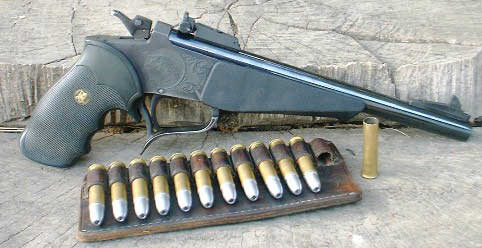 |
|
10" T/C Contender in 40-50
Sharps Straight. |
The inspiration for this story can be found in J. D. Jones' project back in 1988
with SSK's custom Contender in the .338 Woodswalker. J.D. designed this round
for walking around and kicking the bushes to see what came out, then be able to
quickly deal a lethal blow at short range. I read that article and liked the
idea, absorbed the concept, and wanted to do something similar, except in .40
caliber, built around a moderately heavy cast HP. It has taken a while, but all
in all it has come together rather nicely (good things take time...).
Let's back up a bit. The Sharps rifle company is well known for making
very accurate, large caliber, single-shot rifles that were used in the 1870s by
the commercial buffalo hunters. There were a number of rounds that were used by
the Sharps folks, but the last one to be introduced was the little .40-50 Sharps
Straight, introduced in 1879, just a few years before Sharps went under. The
original ballistics produced a 265 grain lead round-nose at 1410 fps. Not
exactly laser-like in its ballistics (but note the similarity to the highly
capable .44 Magnum). THIS was what I was looking for -- moderate pressure
ballistics that were easily compatible with the Contender frame, along with a
simple rimmed straight case with a powder column suitable for a handgun-length
barrel. I bought a 10mm Contender barrel (with a cast bullet friendly 1 in 16"
twist) and re-chambered it to .40-50 Sharps Straight using a reamer that I
rented from Cliff LaBounty. Dies came from RCBS and I managed to find a handful
of moulds from Lyman/Ideal. Load development revealed that it was easy to
reproduce the black powder ballistics from a 10" Contender, well within the
pressure limitations of the Contender frame. A variety of powders were used and
the best accuracy and uniformity was found with 3031 and 4895.
One of the moulds I picked up was an old single-cavity Ideal 403149, the
old 330 grain round nose with three grease grooves, made for the .40-70 and
.40-90 Sharps (both the Straight and Bottlenecked versions of these cartridges).
I sent this mould off to my good friend Erik Ohlen at
Hollow Point Bullet Mould Service
(email @
modify@hollowpointmold.com), (541)738-2479) and asked him to
convert it to drop HP bullets with a cavity .120" in diameter and .400" deep,
tapered and with a rounded HP tip. The mould came back modified exactly as
requested and it cast fine bullets right away. They weighed 315 grains, and were
.405" in diameter (just perfect for this particular gun).
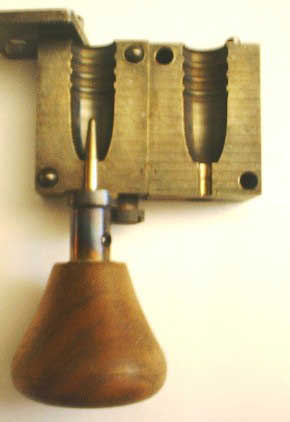 |
|
403149
HP mould. |
I lubed them with 50/50 beeswax/moly grease and started working up
loads. The best combination of velocity and accuracy was found with 35.0 grains
of 4895, for a velocity of 1320 fps. Accuracy was very good, although point of
impact was higher than I could accommodate with the factory open sights, so I
had to make a taller new front sight blade to bring point of aim to jive with
point of impact.
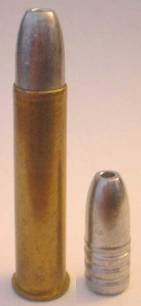 |
|
Loaded
round and 403149 bullet. |
|
Cast HP’s have their limitations. As a general statement, cast HP’s tend
to work best between about 1000 fps and 1600 fps. 1350 fps should be a very
comfortable velocity for the 403149 HP. In addition, I asked Erik to give this
HP a cavity that was roughly 1/3 of the bullet's length, so that way there would
be lots of residual weight (shank) should the nose be lost during expansion.
Expansion testing was carried out by shooting these loads lengthwise through a
2L pop bottle full of water, into a stack of dry newsprint. The fibers of dry
newsprint are very hard on a bullet, and if it survives these conditions it will
most likely perform beautifully in the field. These tests revealed that
expansion was positive with the 403149 HP at 1350 fps when cast to a BHN of
about 12 -- mass retention was better than 70% under in this tough test. It was
time to go shoots some pigs!
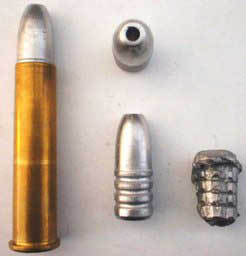 |
|
Recovered
bullet. |
Due to some complications (which can be blamed on the airlines), I was
running late, and John and I didn't make it down to Clover Creek until almost
10pm the night before our hunt. We met Rick and Moose, who had beat us down
there by several hours. Not surprisingly, as seems to always happen when you get
a group of hunters together with the goal of making meat, we stayed up later
than we should have talking about guns, hunting, knives and cast bullets. Good
stuff! We hit the sack well after midnight.
I woke those sleepy-heads up a little
after 5am with the smell of freshly brewed coffee and sizzling breakfast sausage
(from the boar I shot last year). I tell you, it didn't take long to get the
crew up and moving with that sort of motivation! We polished off breakfast in no
time, packed up and headed out. We parked on top of a favorite finger-ridge and
moved out. We found the pigs quickly (or more accurately, I should say they
found us). It seems that the wild hogs have pretty much been hunted out on this
ranch and the hogs
that were there for our hunt weren't terribly wild (having been removed
from the barnyard by only about a month and a half). Well, the hogs may not have
been very wild, but the countryside was, and the weather was beautiful, and all
in all it made for a lovely setting to teach a couple of first-timers the fine
art of making pork. This scenario didn't appeal to Moose and he dropped out, not
wanting to shoot something that wasn't sprinting away from him. Rick and John
each wanted to shoot their first pig. Me, I had a .40-50 Sharps Straight
Contender loaded with a 403149 HP that I wanted to field-test, and besides, I'm
a Southern boy and I love barbequed pork! The pursuit was on!
Rick took the lead. He was hunting with a .44 Magnum Ruger Super
Blackhawk loaded with a modified 429640 HP (in place of the wide-mouthed cavity
of the Devastator, Rick had Erik Ohlen make a new pin profile to duplicate the
cavity I used on my RCBS 300 HP (HP
cavity of .150" diameter at the mouth, cavity with 7 degree taper and extended
.250" into the bullet with a rounded tip. Erik also removed the gas check shank
to cast a plain base bullet)
-- a bullet I had used a few months earlier on a hog and it had expanded
beautifully and punched right through and exited). After trailing the herd for a
while, Rick was able to line up a 35-40 yard broadside shot on a 250-lb sow, and
he placed the shot perfectly -- just behind the shoulder, about halfway up. The
shot knocked the hog down, but it regained its feet and trotted off into the
bushes. Rick followed her through the junipers and was able to eventually get a
few more shots off. He hit her twice more (both low in the throat), but didn't
stop her. She went down into a drainage and holed up in some brush. He was able
to line up a shot and put a SWC through the top of her head, putting an end to
the chase.
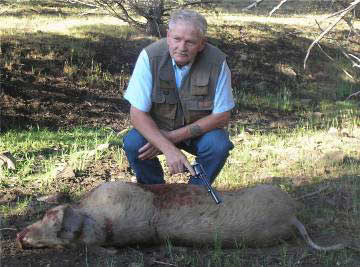 |
|
Rick and his sow. |
Later, during the gutting and skinning, we learned that in spite of the
excellent shot placement, the bullet had failed miserably, fragmenting badly and
not even penetrating the ribcage (less than 2"). There was about 8" of
"hamburger" surrounding the entrance wound, and much bloodshot meat. We couldn't
find any fragments, but it was obvious from the shredded meat that the bullet
had come unglued, and quickly. The lungs were bruised, but still intact, and in
fact the ribs weren't even broken! I would have thought that a 285 grain cast
bullet out of a .44 Magnum cast out of WW alloy and traveling 1320 fps would
have punched right through a 250-lb hog (I have shot several hogs with cast HP’s
and these bullets routinely punch right on through), but not this time. I still
think that the bullet design is a good one (good weight, good meplat, shallow HP
cavity), but I don't have an explanation for the failure. My best guess is that
it has something to do with the alloy, but Rick did the "hammer-smash test" on
some of his bullets and they held together nicely and did not shatter, so I am
at a loss to explain it. The bottom-line is that Rick stuck with it, put himself
in a place to apply a finisher, and the animal was not lost.
John has just gotten into shooting in the last year, and I've been
working with him over the course of the spring to introduce him to the basics of
handloading. He has a .308 bolt-gun, and we had worked up a load of 44.0 grains
of Winchester 748 underneath a 180 grain Speer Hot-Cor (Winchester cases, Fed
210 primer), which produced good accuracy and right at 2600 fps, and he used
this load to practice with this spring. For the hunt, he was using the same load
with the 180 grain Nosler Partition. After Rick had his pig down, we left Rick
and Moose with Rick's pig and John and I followed after the retreating herd.
There were a couple of shot opportunities that almost gelled, but something
about them didn't feel right, so John brought his gun down, and worked to get
himself in a better position (that kind of patience in a new hunter is
unusual!). Soon thereafter, the herd moved out onto an open grassy meadow and
John dropped down into a kneeling position and lined up a 50-yard broadside shot
on a spotted sow. The .308 barked once and the 180 grain Partition went in just
behind the right shoulder, about halfway up. The 250-lb sow jumped slightly at
the impact, then her front legs stiffened and her back legs went out from
underneath her, and she collapsed without taking a step. I was a couple of steps
behind John (just in case he needed help tracking, etc.), and couldn't have been
more pleased with both his patience and shot placement. I gave him a quick
congratulatory pat on the back and then moved off to get my own pig.
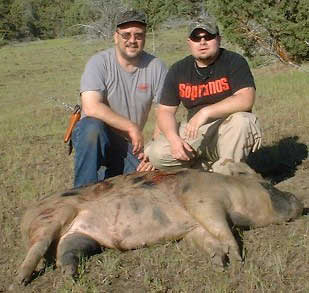 |
|
John (right) and
Glen (left) |
|
with John's
spotted sow. |
|
I worked my way out to the right in order to get a clear shot, and
picked out a nice-sized meat hog that had circled around to give me a broadside
presentation at 35-40 yards. I brought up the 10" .40-50 Sharps Straight
Contender and the front sight settled in snugly behind the left shoulder. The
250-lb sow was standing broadside, facing my left (slightly uphill), and the 315
grain cast HP (403149 HP converted by Erik) went right where it was told. She
turned in a tight spiral and walked quickly away from me, making it only 10-15
feet before collapsing, with a geyser of blood coming up out of her right side,
so I knew right away that the cast HP had punched out the far side. Later, I
found very little bloodshot meat surrounding the bullet hole, consistent with
the modest velocity of the .40-50 Sharps Straight. There was a 1 1/4" hole
shredded through both lungs, with 6" of bloodshot tissue surrounding the hole,
and the holes on the inside of the ribcage were both the size of a 50 cent
piece. The exit wound in the offside hide was about the size of a nickel, and
had bled freely. During the gutting and skinning process, I found no bullet
fragments (not that that means much). Clearly, expansion of the 403149 HP was
positive, and it seemed to hold together well. All in all, the .40-50 Sharps
Straight Contender lived up to J. D. Jones' vision of the Woodswalker concept
very nicely, and the 315 grain cast HP had performed very well indeed.
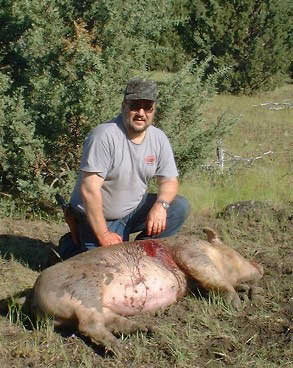 |
|
Glen with his hog. |
On a side note -- at this point in my life I am well into the Age of
Bifocals, which means that shooting iron-sighted handguns takes on new
challenges. A buddy of mine told me how much he liked no-line bifocals since the
"transition zone" between the two different lenses allowed him to get a workable
(not perfect) sight picture, but still have enough resolution on the target for
precise bullet placement. During my last eye exam, I had opted for no-line
bifocals and this was my first time hunting with them. I was delighted with how
quickly I could get a good clean sight picture and precise shot placement with
them. It was almost like I was 35 again....
OK, so now we had three hogs on the ground, time to get to work. I
showed Rick how to field dress his hog, and then coached John through his while
I gutted mine out. Shane hauled the pigs down to the skinning shed for us and
got them hung up, and then I demonstrated how to skin a hog, and coached Rick
and John through getting their hogs skinned and into the chiller. That night we
had grilled steaks and sausage and stayed up past midnight telling stories
around the campfire.
The next morning we were up early, had a big breakfast and went out to
look over the animals. We saw yak, bison, 4-horned rams, Merinos, Catalinas,
watusi, Corsicans, Black Hawaiians, and more. We came back down to camp and I
showed Rick and John how to cut up a hog. As a result of showing two new hunters
how to gut, skin and butcher a hog, I did a fair amount of knife-work on this
trip, and had the opportunity to work with several different knives. While all
of them did good work, there were two that really stood out and turned in
exceptional service -- the A. G. Russell Loveless drop-point hunter made out of
ATS-34, and the Gerber Gator with the drop-point blade made out of 154CM. Both
are easy to sharpen (on a 600 grit diamond stone), both will readily take a
shaving edge, and both will hold that edge very well indeed. Both John and Rick
were using versions of the Beretta Loveless drop-point hunter (a personal
favorite of mine, made out of AUS-8), and those knives also did fine work.
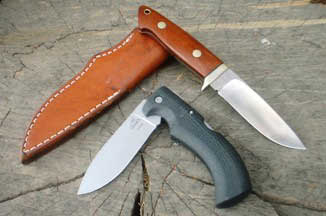 |
|
Some of the knives used. |
It was a sunny
couple of days, and two new hunters took their first hogs and learned how to use
their knives. We learned some things, saw some beautiful country, some
spectacular animals, and enjoyed a campfire and the grilled meat that came off
of it. These are the things that have taken hunters back to hunting camp for
centuries. On top of all this, I had the pleasure of meeting new friends, of
watching a young man I've known since he was 4 years old be patient and make an
excellent shot, and I learned that the .40-50 Sharps Straight makes a dandy
hunting round in the Contender, especially when it's loaded with a heavy cast HP
at BP speeds. Yes, it was a good hunt. You'll have to excuse me now, I have to
go turn the sausage.
|